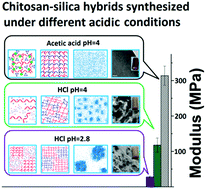Robust and nanostructured chitosan–silica hybrids for bone repair application
Abstract
In this study, chitosan–silica hybrids (CSHs) with superior mechanical strength and homogeneous dispersion of nano-sized silica particles were synthesized via a facile sol–gel method aiming for bone regeneration. The effects of varied acidic conditions of sol–gel reaction and inorganic/organic ratios on the performance of the hybrid were investigated. CSHs synthesized under weak acidic conditions (acetic acid, pH 4.0) showed a homogeneous nanostructure and robust strength (maximum compressive strength: 42.6 ± 3.3 MPa and 271 ± 31 MPa in wet and dry forms, respectively). However, those developed under the strong acidic condition (HCl, pH 4.0) and the strong acid condition plus lower pH (HCl, pH 2.8) tended to aggregate and exhibited inferior mechanical properties (compressive strength: 6.3 ± 0.3 MPa in wet form at pH 2.8). Under the latter conditions, the interactions between silica and chitosan were weak. Moreover, the mechanical properties of the CSHs could be tuned in a wide range by conveniently varying the inorganic/organic composition ratio between 50% and 70%. In vitro cytocompatibility study indicated that CSHs were non-cytotoxic. These results suggested that the weak acidic sol–gel process were essential for fabricating chitosan–silica hybrids with high mechanical strength, which had potential to be applied as a bone substitute.



 Please wait while we load your content...
Please wait while we load your content...